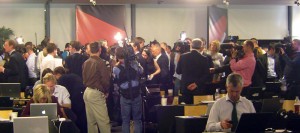There’s plenty of press coverage of the recent, much anticipated, announcement of the approval of the Wi-Fi Direct standard. On the surface non-technical folks would be unlikely to give it a second thought but if you rely on Wi-Fi networks at events then Wi-Fi Direct could be a cause for concern. So what exactly is it and why the concern?
In simple terms think of Bluetooth but using a Wi-Fi standard i.e. device to device communication without the use of a ‘Wireless Access Point’. OK , but we have Bluetooth so why bother? Potentially better range, better performance and a single wireless standard across devices. Also factor in that Bluetooth has never really made it big in the US whereas Wi-Fi has.
But the more technical folks already know how to do ‘ad hoc’ wireless networks today using laptops and wireless adapters so what’s the difference? Not a lot, other than making it simpler and giving it a standard so that a wider range of devices can be certified. Sounds great, so I can connect my laptop directly to my wireless printer? Yes, and any other device that becomes ‘Wi-Fi Direct Certified’.
On one level Wi-Fi Direct is potentially a great addition to the connectivity tool-set, not a replacement for Bluetooth but a complimentary offering, a sort of next level up from a Personal Area Network (PAN), however there is a downside.
The downside is two fold, firstly imagine what happens when you put hundreds of users in a small space all firing up Wi-Fi Direct. Remember what used to happen in a room full of laptops with infrared connectivity and the constant ‘whoosh’ noise as they all kept finding one another and tried to establish a connection! Imagine that over a much wider area with all types of devices.
Today we are still seeing issues at events with the virus which creates an ad hoc network on an infected computer (using a very similar approach to Wi-Fi Direct) called ‘Free Public Wi-Fi’. Unsuspecting users connect to this and then become infected themselves. This virus has been around for some time but has recently gained more press coverage, thankfully it is easy to resolve but it is a nuisance at events where we often see dozens of infected computers.
The second issue is one of interference. The 2.4GHz frequency range that the majority of current Wi-Fi devices use is highly congested. Everything from microwave ovens to Bluetooth devices emit radiation around this frequency, all of which appears as interference to Wi-Fi devices and reduces performance. Now add in hundreds of Wi-Fi Direct networks all emitting in the same frequency range and chaos results. Recent large launches such as the iPhone 4 were hampered by interference caused by hundreds of MiFi devices; Wi-Fi Direct will add a whole new level of interference.
So how bleak is the situation? Hopefully the Wi-Fi Direct standard will address these concerns but details are hard to find at present. Also many of these aspects exist in one form or another today and hence already have to be managed at event sites but it does place increased pressure on the professional network. Two major factors which come into play and can assist are the use of the 5GHz frequency range for critical services where currently there is far less interference (although that is changing). The second factor is to use equipment designed for difficult environments, features such as interference rejection (using aspects such as beam-forming) and automatic channel management become highly important in maintaining a usable network.
The picture may become clearer as more details are made available around the Wi-Fi Direct standard but for any organiser planning on the use of Wi-Fi at an event, especially where there is likely to be a high density of users such as a media centre, it is critical they engage a professional team who have the right tools, equipment and experience to minimise the risk and deliver a quality network.






